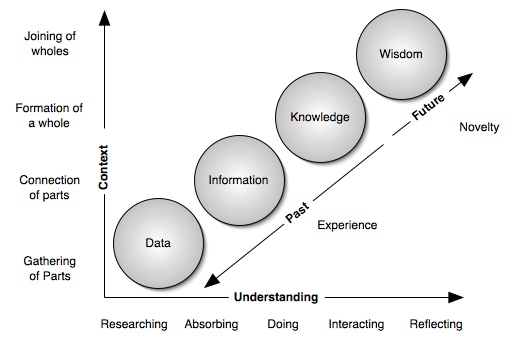Note: This site is moving to KnowledgeJump.com. Please reset your bookmark.
Context
Context: weaving together or connection of words. Weaving parts into a whole so as to form a structure. - Webster's New Collegiate Dictionary
Context shapes our perception and interpretation of meaning. All information, and knowledge that we have comes to us immersed in a variety of contexts. In order to understand or communicate meaning, we must attend to the contextual clues attached to each meaning. (Shedroff, 2001)
Patterns and context are closely related. A pattern tends to create its own context rather than being context dependent to the same extent that information is (Bateson, 1988; Senge, 1990).
Context normally comes in three forms:
- Explicit context is easily recognized, such as a letter or a book. Its "organization" easily stands out.
- Hidden context are subtle clues that we must learn to identify. It is often extremely hard to verbalize properly and may not be constant. It is often the most difficult attribute for understanding a concept.
- Presentation is how the data or information is arranged. Since this organization is conceptual, the presentation can create its own meaning or highlight it. Or as Marshall McLuhan was famous for saying “The medium is the message.”
Thus, when interpreting data, we use explicit means, such as text, visuals, and experience; hidden context, such as gestures, clues, and hunches; and presentation to form and shape the information. When we tie strings of information together and add complexity... we form Knowledge.
Although we need context to fully form our information, too much of it causes noise:
Even with the radio era in full swing, one's senses encountered nothing like the bombardment of images and sound that television would bring—accelerated, flash-cut, disposable knowledge. For now, knowledge was scarce and therefore dear. It was the same for scientists. The currency of scientific information had not yet been devalued by excess. - Genius: The Life and Science of Richard Feynman by James Gleick
The context axis (see the "Understanding Continuum" chart below) has a beginning and an end:
- Gathering of parts: To form a structure or meaning, there must be parts. These parts are composed of bits of data. The only context in data, are other relationships with other bits of data.
- Connection of parts: To start giving meaning to the parts (data), we arrange them into a presentation, such as text or speech. Generally, the only context to information is its presentation.
- Formation of a whole: To become whole, deeper contexts or complexity are added to it. This addition provides the person with experience. Thus, knowledge is gained through experience.
- Joining of wholes: Wisdom has a number or wholes or patterns. These patterns allow the person to join the various wholes that can be used in novel ways.
Thus, if you do not gather enough parts, you have nonsense. And too many parts coming in at once create noise.
More on Hidden Context
The search for clues to discover meaning can be quite creative. For example, a reader who does not know the meaning of a word may look for contextual clues in the surrounding text. These clues may be either semantic or syntactic. When using semantic clues, the reader tries to relate the word to other information or illustrations in the material. Semantic clues include comparisons and contrasts, definitions, descriptions, and the placement of new words near familiar words that help explain their meaning. A reader may also rely on syntactic clues—that is, the word's position and grammatical use in the text. For example, deciding whether a word is functioning as a noun, verb, adjective, or adverb can help a reader figure out its meaning.
Next Step
Click on the various parts of the chart to learn more about that topic

References
Bateson, G. (1988). Mind and Nature: A Necessary Unity. New York: Ballantine.
Senge, P. (1990). The Fifth Discipline: The Art & Practice of the Learning Organization. New York: Doubleday-Currency.
Shedroff, N. (2001). “An overview of understanding” in Information Anxiety 2 by Richard Saul Wurman. Indianapolis: Que.

